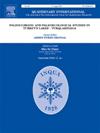西巴尔干地区旧石器时代中期晚期和旧石器时代晚期早期:来自Šalitrena Pećina(塞尔维亚)的石器组合
IF 1.8
3区 地球科学
Q3 GEOGRAPHY, PHYSICAL
引用次数: 0
摘要
Šalitrena Pećina是研究巴尔干半岛北部Peripannonian地区旧石器时代晚期和晚期的重要多职业遗址之一。在这里,我们介绍了洞穴入口的发现和该遗址旧石器时代中期序列的新(ESR)日期。旧石器时代中期地层(6e-6a)的年代介于MIS 5末期(约77 ka)至约40 ka之间,包含具有中等突出的勒瓦卢瓦成分的莫斯特组合,其中完全没有奎那方面。从第5层收集到丰富的上旧石器时代器物组合,属于中奥日尼亚世,经放射性测定,其年代为36-33 ka cal BP。该组合包含狭窄的前部烧灼式核心,扭曲和直叶片,以及不同的工具类型-包括烧灼和修饰叶片。Šalitrena Pećina的Mousterian和Aurignacian年代学以及该地区其他旧石器时代遗址的数据支持这样的观点,即现代人沿着多瑙河和萨瓦走廊向中欧和西欧扩张,尼安德特人群体在巴尔干半岛西部比在东部生存的时间更长。本文章由计算机程序翻译,如有差异,请以英文原文为准。
Late Middle Paleolithic and Early Upper Paleolithic of the Western Balkans: lithic assemblages from Šalitrena Pećina (Serbia)
Šalitrena Pećina represents one of the key multi-occupational sites for studying the late Middle and early Upper Paleolithic in the Peripannonian region of the Northern Balkans. Here we present the findings from the cave entrance and the new (ESR) dates obtained for the Middle Paleolithic sequence of the site. The Middle Paleolithic layers (6e-6a), dated between the end of MIS 5 (c. 77 ka) to c. 40 ka, contained Mousterian assemblages with a moderately prominent Levallois component, in which the Quina aspect is completely absent. A rich Upper Paleolithic artifact assemblage attributed to the Middle Aurignacian was collected from Layer 5, which has been radiometrically dated to 36–33 ka cal BP. The assemblage contains narrow front burin-like cores, twisted and straight bladelets, and different tool types – including burins and retouched blades. The Mousterian and Aurignacian chronology of the Šalitrena Pećina and the data on other Paleolithic sites in the region support the notion that the expansion of modern humans towards the Central and Western Europe occurred along the Danube and Sava corridors and that Neanderthal groups survived longer in the western than in the eastern part of the Balkan peninsula.
求助全文
通过发布文献求助,成功后即可免费获取论文全文。
去求助
来源期刊

Quaternary International
地学-地球科学综合
CiteScore
5.60
自引率
4.50%
发文量
336
审稿时长
3 months
期刊介绍:
Quaternary International is the official journal of the International Union for Quaternary Research. The objectives are to publish a high quality scientific journal under the auspices of the premier Quaternary association that reflects the interdisciplinary nature of INQUA and records recent advances in Quaternary science that appeal to a wide audience.
This series will encompass all the full spectrum of the physical and natural sciences that are commonly employed in solving Quaternary problems. The policy is to publish peer refereed collected research papers from symposia, workshops and meetings sponsored by INQUA. In addition, other organizations may request publication of their collected works pertaining to the Quaternary.
 求助内容:
求助内容: 应助结果提醒方式:
应助结果提醒方式:


